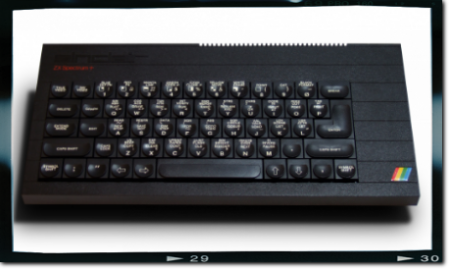48k memory, 8 colours, and sound.
It's 1982, and Sinclair released two versions of the 8 bit Spectrum; the 16k and the 48k.
I remember walking into Dixon's, in Windsor, and told the shop assistant that I wanted to buy the 48k Spectrum. I also remember the shop assistant's responce:
"Why do you want so much memory? What are you going to do with it, that you need all that memory?"
I knew how much the old 16k ZX81 struggled with just black and white graphics, but the Spectrum was a whole new ball game, with colour and sound. Anyway, I stuck to my guns, and walked out with a 48k Spectrum, and left a very disappointed shop assistant who didn't earn his commission on the sale.
The Spectrum still used the old cassette tape method of loading software, with the same old problems, overcome by the same old method of playing the tape at full volume. Only this time, instead of a load of black and white squiggly lines going across the screen, we had a colour loading screen with a blue and yellow flashy border.
The Spectrum also had an expansion port at the rear, and third party manufacturers very soon started producing add-ons for the computer. Joystick interfaces were among the first to appear, the most popular of which was the Kempston. One company even made a digital drum processor for it, and it sounded very impressive when played through the stereo.
Then one company (which I forget the name of) bought out a paint program which worked by using a light pen on the tv screen. It wasn't perfect, and it wasn't easy, especially having to sit so close to a glaring tv screen. This was my introduction to computer graphics.
The way the Spectrum handled the graphic display made producing colour images very difficult. Each block of 64 pixels could only display 2 colours at any time, and depending which pixels were used also effected any ajoining blocks. It was a nightmare. Even so, it ignited a spark, but sadly any pictures I made could only be saved to a cassette tape, and there was no way to save it to any other format. Basically, because there was no other format.

One of the biggest criticisms about the Spectrum was its rubber keyboard. It was commonly referred to as having a "Dead Flesh" feel to it. There were several DIY fixes around, but eventually Sinclair addressed the problem by releasing the Spectrum+. Essentially a 48k Spectrum with an improved keyboard, with additional keys for some of the more common functions putting an end to some of the tortuous finger combinations.
Thanks to popular demand, Sinclair released a DIY pack. After removing the motherboard from the old enclosure, and a little bit of soldering, the board was then placed into the new keyboard case.
Sinclair did release a couple more computer models, but I stuck with my 48k Spectrum in its "+" case until August 1986.